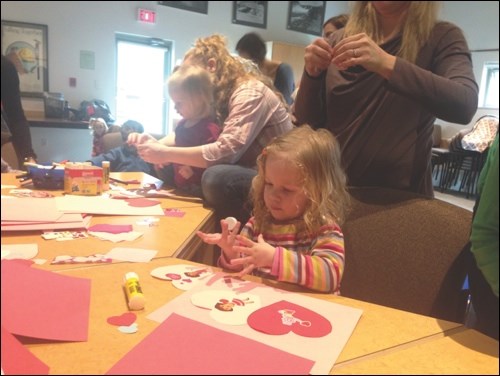When Squamish rain keeps children inside, the fun needn’t end. Indoor craft activities are not only great for keeping busy toddlers occupied, they also make learning fun, say local educators.
“It’s about the experience of having paint on your hands, on your face and in your hair… it is always messy,” says Alex McKimm, an early childhood educator at Platypus Playcentre.
It’s about exploring their sensory world, she says. “Different feelings and textures are really important as a toddler. Being exposed to those things can save issues later in life.”
Nicole Harper, an assistant at Child Care Resource and Referral, agrees. She sets up craft activities at the weekly CCRR playgroup and always makes sure there’s a variety on offer, from homemade playdough to shaving foam and finger paints.“It’s really important they explore different senses, different feelings, different sensations. It’s great for their minds and getting to know the world around them.”
They’re also building vital life skills, explains McKimm. “Fine motor skills like gripping, grabbing and pinching are all really important skills that are almost exclusively offered through creative expression and art.” For example, she explains, art can help children graduate from gripping a paintbrush in their fist to using a pincer grasp with finer control.
Harper adds that creative activities also help with colours, numbers, sharing and social awareness.
To help toddlers get the most from their experience, it’s important that parents and caregivers model the behaviour they want to encourage. Getting messy together not only offers a wonderful bonding opportunity, it may also extend the activity, says McKimm. “Don’t think an art experience is going to entertain them by themselves. An art experience is something that you and your child need to do together.” It’s a great time for conversation and cooperation, she adds.
Layered projects, she suggests, are a way to extend the creative session. Crayons, for example, can be washed over with watercolours to make visually stimulating patterns; it’s best to use colours that blend well together, such as purples and blues. She also recommends using big surfaces, “When working on smaller spaces, toddlers can get frustrated trying to stay on the paper or within the lines.”
Harper suggests trying not to fixate on the outcome. Just enjoy the experience together and offer simple guidance where needed, she suggests.“Keep it open-ended so they’re experiencing and creating what they choose. You’re not looking for an end result.”
McKimm agrees. “If you’re looking for an end product with toddlers, you will always be frustrated and disappointed. It’s about the experience.” And let them quit when they want, she adds, explaining that forcing toddlers to finish a project may create such a negative experience that they avoid that craft in the future. “If they’re getting frustrated, feel free to let it go.”
For art experience inspiration, Harper suggests looking online. She says crafting needn’t be expensive. “As long as you have an imagination you can probably come up with some pretty creative ideas with stuff around the house.” Think twice before throwing out a tissue box or toilet paper roll, she suggests, as it could make an art accessory.
Other craft cupboard items could include leaves, feathers, pipecleaners, stencil brushes, macaroni, chunky crayons, glue, sequins, sparkles, pompoms, cotton balls, paint…. the list is as long as your imagination.



